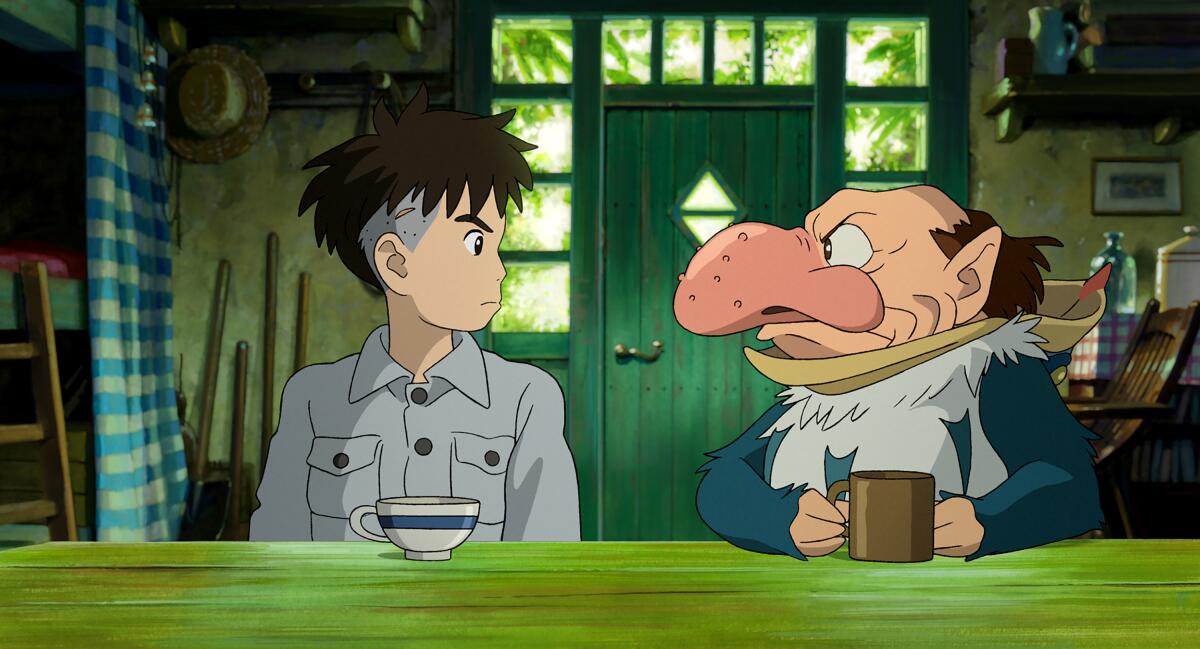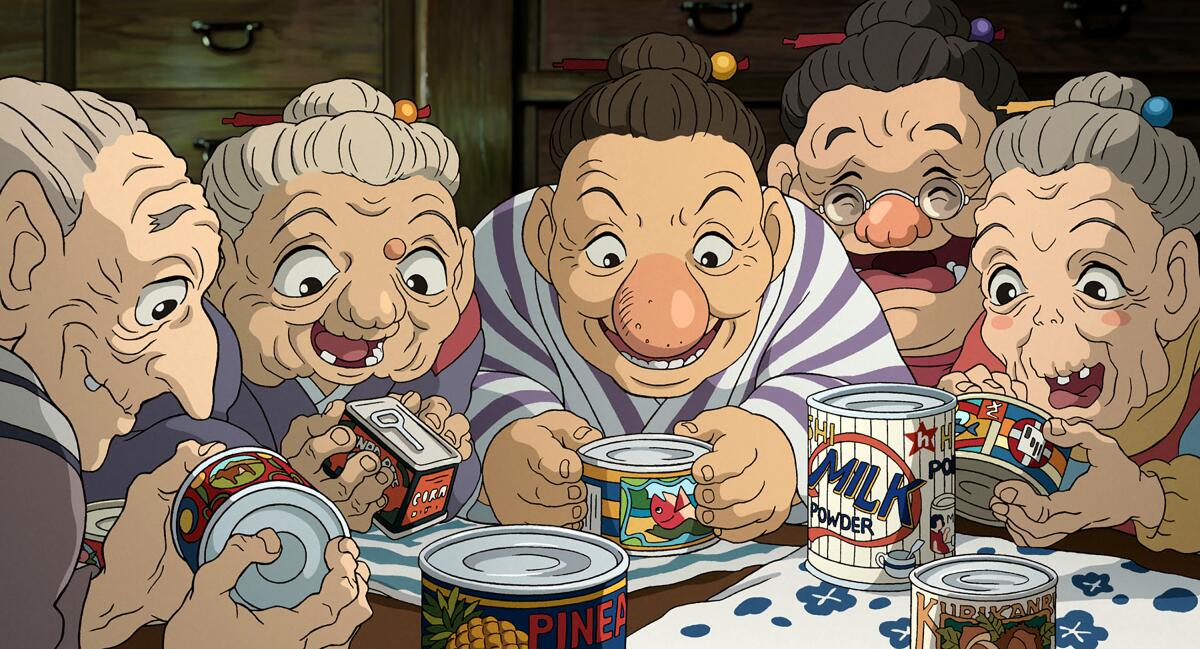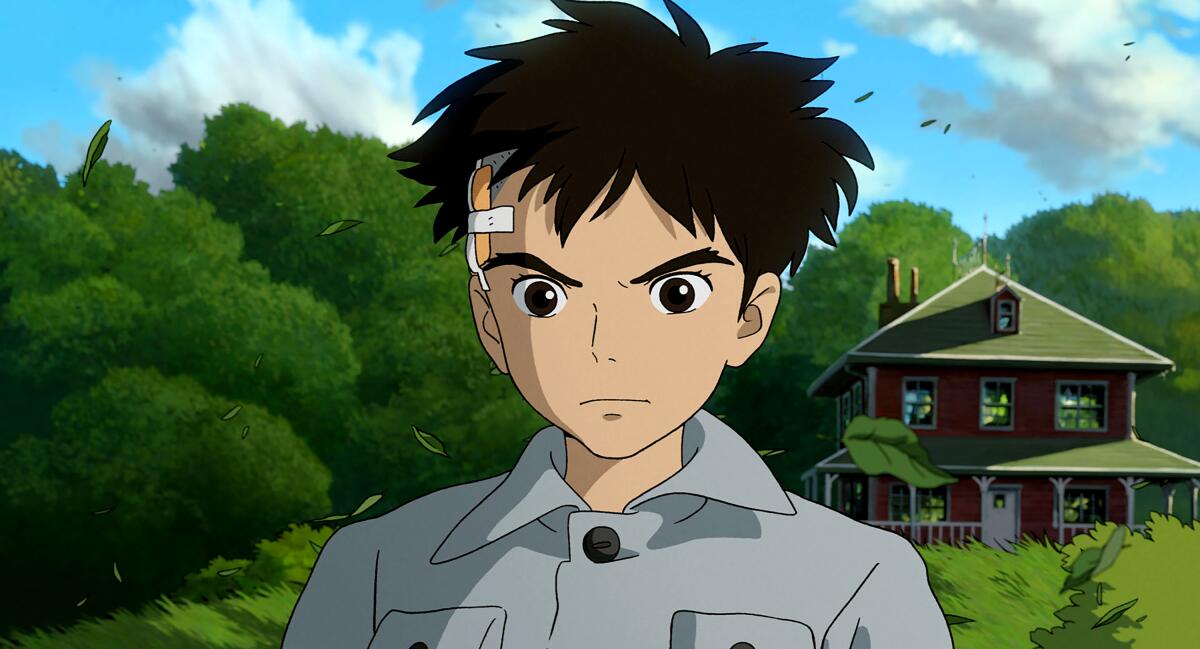‘The Boy and the Heron’ is Hayao Miyazaki at his most beautifully elegiac

- Share via
The very last moment in “The Boy and the Heron” is the simplest, loveliest, most quietly shattering thing. It could hardly be otherwise, being the final scene of purportedly the final work from the great Japanese animator Hayao Miyazaki. I’m reluctant to say more, not just because the image itself defies description, as Miyazaki’s art often does, or because I’m wary of spoilers, since his teeming, restlessly inventive stories have long been liberated from the prison of (yawn) narrative logic. Let’s just say that this parting shot feels like an end and a beginning, a departure and a return, a reminder of all the imaginative wonders that can spring from the dimmest recesses of a boy’s memory. He may be learning to put away childish things, but the movie around him embraces them without fear or apology.
The boy (voiced by Soma Santoki) is named Mahito, and we meet him in 1943, on the terrible night his mother dies in a hospital fire in Tokyo. Amid a blur of slow-drifting embers and fast-moving bodies, he races to try and save her while air-raid sirens scream overhead. It’s a wartime conflagration that will haunt Mahito throughout this gorgeous, somber yet thrilling movie, even after his father sends him, a year later, to live in the countryside with his stepmother-to-be, Natsuko (Yoshino Kimura). As Mahito wanders a strange new house and its lush, wooded surroundings, followed here and there by a bevy of gossipy grannies, he can’t shake his grief, his guilt or a startling hallucination of his mother rising, phoenix-like, from the flames.
The most significant bird here, however, isn’t a phoenix. Nor is it one of the many giant green parakeets who, late in the proceedings, form a menacing avian army. It’s the mysterious gray heron that descends early on from its rooftop perch and swoops down perilously close to Mahito, allowing us to study its magnificent wingspan, its unnerving dark eyes and its sharp, red-tipped bill. Before long that bill opens to reveal a row of alarmingly humanoid teeth, and also to deliver a strange and faintly sinister invitation: “Your presence is requested.”

It is indeed. Like Lewis Carroll, L. Frank Baum and other great enchanters before him, Miyazaki, now 82, delights in ushering us, alongside his young heroines and heroes, into ravishing storybook worlds that are at once scarily unquantifiable and eerily recognizable. The portals to these worlds are especially crucial for what they reveal about not only the visual architecture of Miyazaki’s imagination, but also the characters’ own states of mind. Here, straddling this dimension and the next, their fear of the unknown gives way to an appetite for adventure. “Howl’s Moving Castle” had its clanging, chicken-legged fortress, an Industrial Age spin on Baba Yaga’s hut, whose doors opened onto fantastical realms. “Spirited Away,” the highest of Miyazaki masterpieces, sent us down a long, dark tunnel and into a seemingly abandoned theme park, full of spectral bathhouses and train tracks to nowhere.
There are tunnels of a different kind in “The Boy and the Heron,” located beneath a mysterious tower said to have been built ages ago by Natsuko’s great-uncle. The place has been sealed off for security reasons, but that’s no impediment to Mahito, who enters the tower seeking answers about his past and his future. It’s here that the heron, in a classically Miyazakian transformation, reveals itself to be something at once more grotesque and more benign: a squat little man with pointy ears, a warty nose and a sense of mischief that doubles as a moral compass. Curmudgeonly and endearing, troublesome and helpful, he’s one of several memorable creations Mahito will encounter on what sometimes feels like a journey to the center of the Earth, or maybe just the oneiric core of Miyazaki’s subconscious.
The heron is scarcely alone in presenting a dual identity. Kiriko (Ko Shibasaki), one of the aforementioned grannies, has at least one fantasy-world alter ego — two if you count the wizened little figurine that becomes a protective talisman for Mahito. Parallel representations of both Mahito’s mother and Natsuko recur throughout the narrative. (Speaking of parallel representations: You can watch “The Boy and the Heron” in its Japanese-language version, as I did, or in the starrier English-dubbed version featuring the voices of Robert Pattinson, Gemma Chan, Christian Bale, Florence Pugh and others.)

Still more doubling abounds: The movie shares its original title, “How Do You Live?” with Genzaburo Yoshino’s 1937 coming-of-age novel, a copy of which figures poignantly into the story. Some will also recall the Paul Valéry quote (“The wind is rising! We must try to live”) that opens 2013’s “The Wind Rises,” which was announced as Miyazaki’s final film before this latest welcome emergence from an apparently premature retirement.
An interwar tale of creation and destruction, “The Wind Rises” ends with a fiery vision of World War II that leads seamlessly into “The Boy and the Heron’s” harrowing opening moments. Those moments were clearly informed by some of Miyazaki’s own childhood memories: He was only 3 when he and his family fled Tokyo, and the images of bombed-out, war-ravaged cityscapes never left him. (Miyazaki’s father worked at a company that manufactured airplane parts, a detail that the filmmaker has bequeathed to Mahito’s father in turn.)
The semi-autobiographical touches are deeply moving, though it would be a mistake to read too much into them, given that Miyazaki has never been impersonal. The movie’s most piercing moment is at once fictional (one hopes) and tethered to painful, unfantastical reality: Mahito, feeling hopeless and abandoned, suddenly lifts a stone and smashes it against the side of his head, drawing a cascade of blood and leaving a scar that lingers until movie’s end. It’s a startling instance of self-inflicted violence that speaks to the fearless, unsparing quality that has always been at the heart of Miyazaki’s work. His empathy with his characters is too profound to spare them the realities of violence and despair, just as he loves them too much to deny them the possibility of wonderment and joy.

How do you live? It’s a question at once casual and momentous, and it reverberates across the high seas and grassy moors of “The Boy and the Heron.” It might run through your head as a young girl spreads jam on a piece of bread, or as a multitude of floating, smiling white puffballs, known as warawara, levitate blissfully skyward. (The fate that engulfs these adorable little creatures, who made my 7-year-old viewing companion gasp with delight, is its own proof of Miyazaki’s ferocious unsentimentality.) Mahito must figure out how to live through the present moment, how he will endure the trauma of war and the pain of his mother’s death. But he must also determine how he will live in the future: what role he’ll play in a family that continues to survive and even grow, and what he will do as a young man and, before too long, an old one.
Toward the end of the movie, Mahito stumbles on a possible vision of his own future, though the question of who this elder sage is — Natsuko’s great-uncle? Jareth the Goblin King? Miyazaki himself? — may have multiple answers or none at all. But who the man is matters less than what he says: to seek balance in all things, live free from malice and do all that we can with the time given to us.
As you leave “The Boy and the Heron,” you may feel strangely bereft, emptied out in a way that I suspect Miyazaki both intends and hopes to console us against. This, I think, is the meaning of that sad yet oddly capacious final image: For one fleeting, breathtaking moment, this magnificent artist clears the screen of all its wondrous sights and sounds, its imaginative detritus and rapturous flourishes — and calls on each of us, as best and as only we can, to fill this space anew.
'The Boy and the Heron'
(Two viewing options: In English or in Japanese with English subtitles)
Rating: PG-13, for some violent content/bloody images and smoking
Running time: 2 hours, 4 minutes
Playing: AMC Burbank 16; AMC Burbank Town Center 6; AMC Century City 15
More to Read
Only good movies
Get the Indie Focus newsletter, Mark Olsen's weekly guide to the world of cinema.
You may occasionally receive promotional content from the Los Angeles Times.











